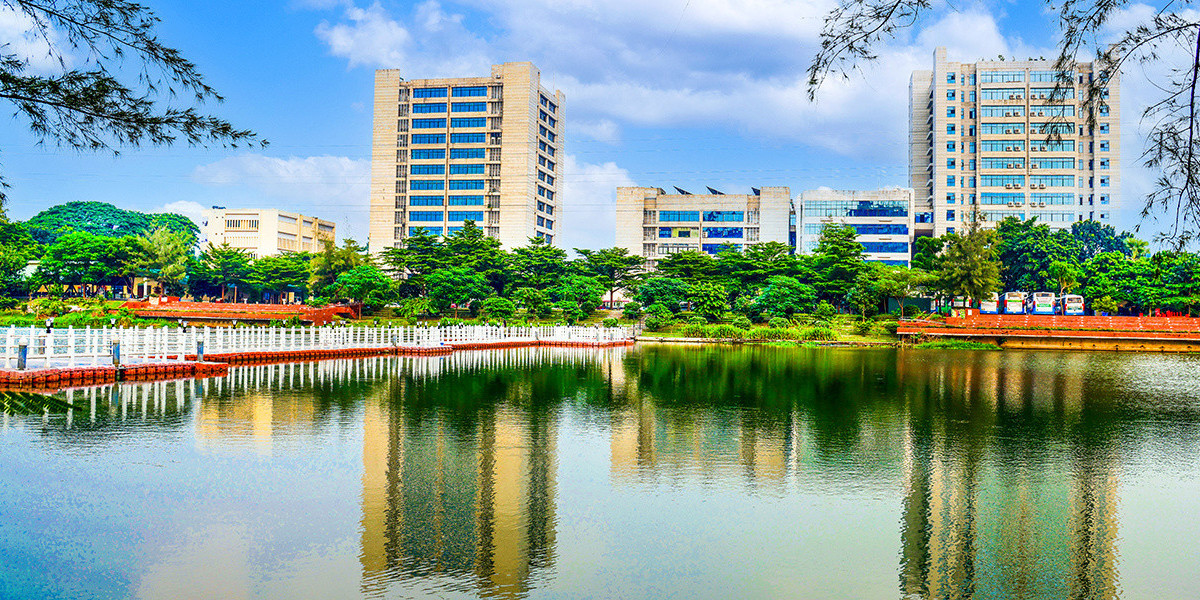Pursue an MBBS in Bangladesh to understand why this South Asian nation has become one of the most practical, affordable, and academically sound alternatives to studying medicine in India. Both Bangladesh and India follow similar educational structures derived from the British system, emphasizing theoretical depth and clinical exposure. However, there are important differences in tuition, living costs, internship structures, and teaching methodologies that make Bangladesh a particularly attractive choice for Indian medical aspirants who do not secure seats in government medical colleges in India. This detailed comparison of MBBS in Bangladesh vs India explores cost, curriculum, clinical exposure, recognition, and overall return on investment.
MBBS Cost Comparison: Bangladesh vs India
One of the biggest factors driving Indian students to Bangladesh is affordability. The total cost of studying MBBS in India can range anywhere from ₹60 lakh to ₹1 crore in private institutions, whereas in Bangladesh, the same degree typically costs between ₹25 lakh and ₹40 lakh, including tuition, hostel, and living expenses.
Average MBBS Fee Structure
| Particulars | MBBS in Bangladesh | MBBS in India (Private Colleges) |
|---|---|---|
| Course Duration | 5 years + 1-year internship | 5.5 years including internship |
| Tuition Fees (Total) | ₹20–30 lakh | ₹60 lakh – ₹1 crore |
| Hostel & Food | ₹1–1.5 lakh per year | ₹2–3 lakh per year |
| Total Estimated Cost | ₹25–40 lakh | ₹70 lakh – ₹1 crore+ |
| Donation/Capitation | Not required | Common in many private colleges |
| Medium of Instruction | English | English |
In government colleges in India, the fees are heavily subsidized, averaging ₹1–2 lakh total. However, the limited seat availability (around 45,000 for over 18 lakh NEET aspirants) means that only the top percentile of students qualify. Bangladesh provides a cost-effective option for those who miss out on government seats but still wish to pursue a globally recognized medical education.
Curriculum and Academic Structure
Both Bangladesh and India follow a similar five-year MBBS program based on the British model, ensuring a seamless transition for Indian students. The difference lies in the teaching style, practical orientation, and emphasis on student-faculty interaction.
Curriculum Overview
| Feature | MBBS in Bangladesh | MBBS in India |
|---|---|---|
| Academic System | Follows NMC (India) & BMDC standards, British model | Follows NMC prescribed Indian curriculum |
| Duration | 5 years academic + 1-year internship | 4.5 years academic + 1-year internship |
| Subjects | Pre-clinical, Para-clinical, and Clinical phases | Pre-clinical, Para-clinical, and Clinical phases |
| Language | English | English |
| Assessment | Yearly professional exams and continuous internal evaluation | Annual exams and internal assessments |
Focus on Practical Learning
Bangladesh medical colleges emphasize hands-on clinical exposure from the early stages of the program. Each college has its own teaching hospital where students participate in patient rounds, OPD management, and minor surgical procedures under supervision. The smaller batch size, typically 80–100 students per year, ensures personalized attention, which is often missing in large Indian institutions with over 200 students per batch.
Internship and Clinical Exposure
Internship is a crucial part of the MBBS journey, and both countries provide extensive hospital-based training. However, there are differences in structure, recognition, and post-internship opportunities.
Internship Comparison
| Aspect | MBBS in Bangladesh | MBBS in India |
|---|---|---|
| Duration | 1 year | 1 year |
| Type | Mandatory hospital-based internship | Mandatory hospital-based internship |
| Recognition | Recognized by BMDC, NMC (India), WHO, and WDOMS | Recognized by NMC and WHO |
| Practical Exposure | High, as students train in the college’s 500–1000-bed hospitals | High in government colleges; varies in private colleges |
| Internship in India | Can be repeated in India post FMGE/NExT exam | Not required (already local) |
For Indian students studying in Bangladesh, the internship done abroad can be recognized in India after passing the FMGE or NExT examination as per NMC guidelines. This allows graduates to register and practice as doctors in India.
Quality of Education and Faculty
Medical education in Bangladesh maintains a balance between affordability and academic rigor. The Bangladesh Medical and Dental Council (BMDC) strictly monitors medical college performance, curriculum design, and faculty qualifications. Most medical universities employ professors trained in the UK, India, or other Commonwealth countries.
In India, the National Medical Commission (NMC) ensures curriculum uniformity and conducts inspections, but the teaching quality varies greatly between government and private colleges. In private colleges, the student-teacher ratio is often skewed, and clinical exposure can be limited if patient inflow is low.
In contrast, Bangladesh colleges benefit from dense populations and high patient loads in both public and private hospitals, offering richer clinical experiences for students.
Recognition and Global Acceptance
Bangladesh’s medical degrees hold wide international recognition, particularly when earned from WDOMS-listed and BMDC-approved institutions. These universities meet the academic standards required by international bodies.
Recognition Overview
| Recognition Body | Bangladesh MBBS | India MBBS |
|---|---|---|
| National Regulator | BMDC (Bangladesh Medical and Dental Council) | NMC (National Medical Commission) |
| Global Listings | WHO, WDOMS, FAIMER, UNESCO | WHO, WDOMS, FAIMER |
| Licensing Exams Eligibility | FMGE/NExT (India), USMLE, PLAB, AMC | USMLE, PLAB, AMC, NExT |
| International Practice Scope | Recognized in India, USA, UK, Gulf countries | Recognized globally |
Thus, graduates from top Bangladesh colleges like Dhaka Medical College, Sir Salimullah Medical College, and Bangladesh Medical College are eligible to take major licensing exams such as FMGE, USMLE, or PLAB, paving the way for global career opportunities.
Living Standards and Student Life
Living in Bangladesh offers cultural and social familiarity for Indian students. Both countries share similar cuisines, traditions, and climatic conditions, making adaptation easy. Moreover, English is widely spoken in medical institutions, and many campuses have Indian student associations that assist newcomers in adjusting to life abroad.
Lifestyle Comparison
| Factor | Bangladesh | India |
|---|---|---|
| Language | English & Bengali | English & regional languages |
| Food | Indian cuisine easily available | Native Indian cuisine |
| Accommodation | University hostels and private apartments | College hostels or off-campus housing |
| Safety | Highly secure university campuses | Varies by city and college |
| Connectivity | Close to India; easy flights | Domestic travel convenience |
The affordable living costs in Bangladesh (approx. ₹10,000–₹15,000 per month) also make it easier for students to maintain a comfortable lifestyle without financial stress.
Career Opportunities After Graduation
After completing MBBS in Bangladesh, Indian students can either return to India or pursue postgraduate studies and medical careers abroad. The MBBS curriculum aligns closely with the NMC pattern, making FMGE or NExT preparation smoother.
Graduates can:
Clear FMGE/NExT to practice in India.
Take USMLE, PLAB, AMC, or MCCQE for international medical licensure.
Pursue postgraduate degrees (MD/MS) in Bangladesh or other recognized countries.
Indian MBBS graduates, on the other hand, face stiff competition for PG seats due to the limited number of postgraduate openings in India compared to the volume of applicants.
Final Comparison Summary
| Parameter | MBBS in Bangladesh | MBBS in India |
|---|---|---|
| Total Cost | ₹25–40 lakh | ₹70 lakh–₹1 crore (private) |
| Curriculum | NMC-aligned, practical-based | NMC-aligned |
| Internship Recognition | Recognized after FMGE/NExT | Directly recognized |
| Teaching Language | English | English |
| Clinical Exposure | High, small batch size | Varies by college |
| Living Cost | ₹10k–₹15k per month | ₹15k–₹25k per month |
| Licensing Exam | FMGE/NExT | NExT only |
| Global Recognition | WHO, WDOMS, BMDC | WHO, WDOMS, NMC |
Conclusion
When comparing Bangladesh vs India for MBBS, Bangladesh offers a balanced combination of affordability, globally recognized curriculum, English-medium instruction, and excellent clinical training. For Indian students, it bridges the gap between expensive private colleges in India and the dream of becoming a globally competent doctor.
With the advantage of WDOMS-listed universities, FMGE/NExT eligibility, and strong faculty mentorship, Bangladesh stands as one of the most practical destinations for medical education in South Asia — ensuring that aspiring doctors can achieve their dreams without overwhelming financial burden.








